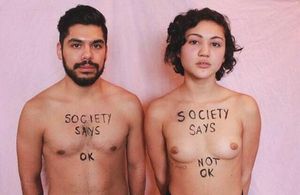Toplessness
Toplessness is a word that refers to a state in which a female’s torso is exposed. Female’s breasts, nipples, and areola are exposed, especially in a public place or in a visual medium. [1]

Sexual offense Act
Under the Sexual Offences Act 2003, it is not an offence to be naked in public in England and Wales. It becomes an offence if it can be proved the person stripped off with the intention to cause distress, alarm or outrage. Then they run the risk of three possible offences, says a spokesman for law firm Kingsley Napley. These are:
- Indecent exposure - an offence under section 66 of the Sexual Offences Act 2003
- Intentional harassment, alarm or distress under section 4A of the Public Order Act 1986
- " "Outraging public decency" under common law
If a case did get to court the onus would be on the prosecution to prove this intention to upset. If found guilty, the offender would face anything from a fine to several years in prison.[2]
Negative impact
In Western cultures, breasts is one of the things that should be hidden in public. Exposing women's breasts in public is viewed as shameful and inappropriate behaviors even in the beaches, and while women are breastfeeding. Moreover, the general breast taboo and the provocative visual images in the media greatly encourage men to view breasts as objects of sexual arousal and play.[3] However, men are naturally being conditioned to see breasts as sexual, but the problem is how advertisements and media depict women's breast.
Advertisements

The primary objectives in advertisements are to attract consumers attention by creating desires for the products. Women's bodies, particularly breasts are frequently used in the advertisement. Breasts are used to advertise products even the products are not related to women. Moreover, women are even pictured eating in bed in a sexualized way, creating utterances or sexualized noises, which is very similar with sexual noises. These kinds of advertisements sexualized women and their bodies. This means that women's bodies are commoditized. Feminist critiques of modern advertisements mention about the problem of sexualization and commodification of women's breasts and reinforcement of narrow beauty ideals and attractiveness. [4]
Breast feeding in public
"see also" Breastfeeding in public
"see also" FirstRight

Breastfeeding in public is a concern whether or not it is acceptable to do. Women have their own rights to breastfeed whenever or wherever they want, but they may fear to get offense if they are breastfeeding. [5] There are arguments against breastfeeding. According to poll in debate.org,[1] 36% of people says that breastfeeding in public is not an appropriate thing to do because they said breastfeeding in public is indecent. Some people feel that breasts are the private parts of anatomy and when even feeding their child, it is morally wrong to expose breasts in public. [6] Not only because it is a morally wrong behavior, it is also an intimate act since the act of breastfeeding is physically and emotionally intimate and, therefore, should not be done in public. It makes others uncomfortable to witness such an intimate moment. [7] However, breastfeeding in public is legal in most countries, so if someone seems to be bothered by breastfeeding mothers nursing, or asks them to leave, they can report to FirstRight, which is a breastfeeding advocacy group committed to ensuring freedom from discrimination for breastfeeding children and their mothers. [8] Their objective are that breastfeeding is a normal behavior and children also have the right to breastfeed in public without being discriminatory actions. [9] Moreover, they also can report to National Alliance of Breastfeeding Advocacy (NABA). NABA collects the information and incidents of breastfeeding discrimination.[10]
Supporting organizations
Topfreedom
Topfreedom is a movement, which seeks for changes in laws to allow women to be topless in public places. Exposure of the breast or toplessness has been encouraged by the topfreedom movement. The topfreedom movement in the United States, Canada, and Europe seeks to advance the idea that women and girls should be able to go topless where men and boys are permitted to do so, as a form of gender equality.[11] They also promote women’s rights to breastfeed in public. However, this movement has come under great legislative challenges for the recognition of its activities. Phoenix Feely is part of Go Topless, and she began a 16-day jail sentence in New Jersey because she refused to pay fines when she was arrested for sunbathing topless at a Spring Lake beach. In 2005, the activist successfully sued the NYPD after being arrested for walking shirtless down a New York City street, where it is officially legal for women to do so. She was awarded a settlement of $29,000, in addition to bringing attention to the often vague or inconsistently enforced toplessness laws in the US. [12] What this organization is trying to say is no to push for the world where everyone goes sans shirts, but rather to push back against what they see as an infringement of women’s constitutional right not to be discriminated against on the basis of gender. [13] Phoenix Feeley and Go Topless would argue in favor of the more progressive second approach by using the law as a tool for the change. Pro-topless equality supporters like them claim that if state and local government facilitate the normalizing of female bodies, people will begin to see women less as sex objects for the taking, a mental shift which could feed a decline in, among other problems, assault. They are pushing for equal laws in an effort because it is not only in order to gain legal fairness, but to change the overall view and perspectives of women in American society.[14]
Go Topless
"See Also" Go Topless [2]
Go topless is based organization founded in 2007 by spiritual leader Rael and they say that women have the same constitutional right that men have to go bare-chested in public. This organization made “go topless day”, which is an event that supports the right of women to go topless. This event encourages women to go topless in public and men to cover their chests by wearing brassieres or bikinis in order to promote gender equality The event, go Topless Day is scheduled for the Sunday nearest August, 26, Women's Equality Day
Free The Nipple
Free the nipple is a campaign named after Lina Esco’s 2014 flim Free the Nipple. This campaign argues for female topless to be permissible in all areas and it aims to advance gender equality and to oppose Sexual objectification Even though there are changes in statutes and regulations legalizing toplessness for women, women are still at risk for being charged with public indecency, disturbing the peace, or lewd behavior.This campaign received attention and kicked off first in 2015 because when student and her boyfriend posted a picture on Facebook of both of them topless in Iceland [15]People decided to free their nipples in solidarity with her, and the Iceland Mp Björt Ólafsdottir also put up a photo of herself with revealing a breast. Finally, #FreeTheNipple film was made by American director Lina Esco, whose friend Miley Cyrus got involved. In an attempt to desexualize female, various other high-profile women, such as Rihanna, Scout Willis, and Cara Delevinge have joined them.[16] [17] [18]
See More
Free The Nipple film official trailer
- Free The Nipple
- Topfreedom
- Topfreedom in Canada
- Public nudity
- History of nudity
- Breastfeeding in public
References
- ↑ Topless. (n.d.).The Free Dictionary Retrieved April 04, 2016, from http://www.thefreedictionary.com/topless
- ↑ http://www.falselyaccused.co.uk/rape-sexual-offences/
- ↑ http://www.007b.com/breast_taboo.php
- ↑ Smith, M. D. (n.d.). Cultural encyclopedia of the breast.3-11
- ↑ http://www.infactcanada.ca/br_bf_in_public.htm
- ↑ http://www.debate.org/opinions/is-public-breastfeeding-appropriate
- ↑ http://gofatherhood.com/2012/08/the-case-argument-against-breastfeeding-public/
- ↑ http://www.firstright.org
- ↑ http://www.firstright.org
- ↑ Lawrence, R. A. (2010). Breastfeeding: A guide for the medical professional. Philadelphia, PA: Saunders p.722-724
- ↑ Lunceford, B. (2012). Naked politics: Nudity, political action, and the rhetoric of the body. Lanham, MD: Lexington Books.
- ↑ http://www.theatlantic.com/national/archive/2013/09/the-social-and-legal-arguments-for-allowing-women-to-go-topless-in-public/279755/
- ↑ http://thoughtcatalog.com/jessica-blankenship/2014/01/why-women-should-be-allowed-to-go-topless-in-public/
- ↑ https://broadly.vice.com/en_us/article/the-history-of-toplessness
- ↑ http://www.theguardian.com/lifeandstyle/2015/apr/06/free-the-nipple-liberation-photos-breasts
- ↑ https://i-d.vice.com/en_gb/article/toplessness-vs-feminism
- ↑ Esco, Lina. Free the Nipple. Disruptive Films Inc., 2014. Retrieved on 20 January 2015
- ↑ Tsjeng, Zing (2015). "What the hell is #freethenipple anyway?". Dazed. Retrieved 2015-12-22